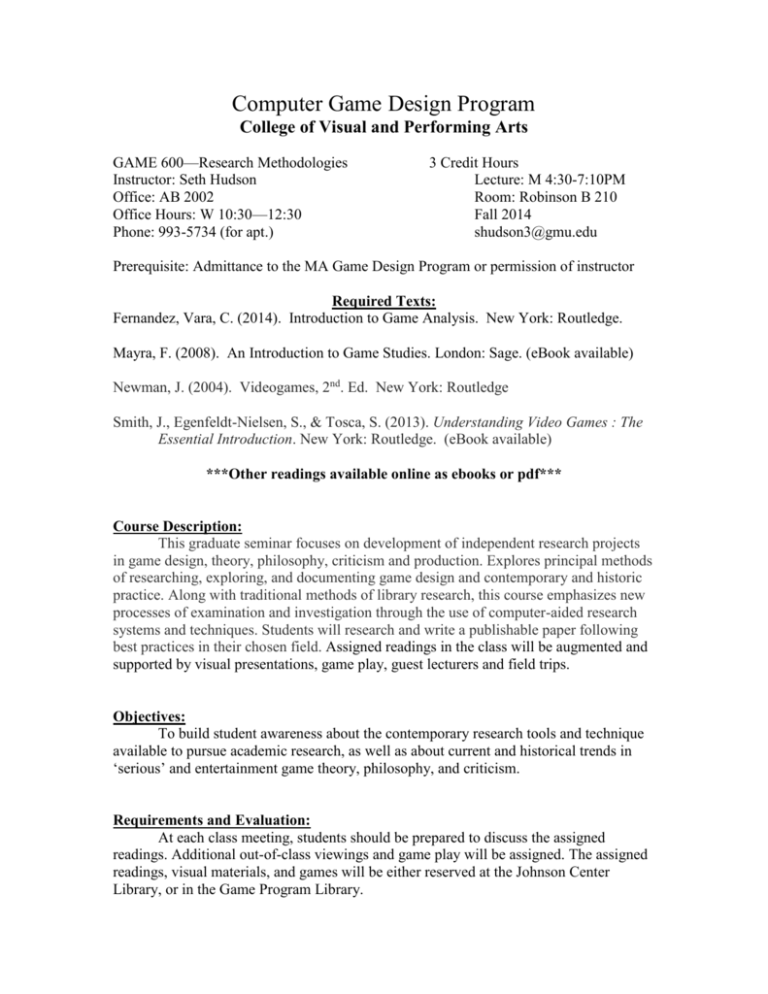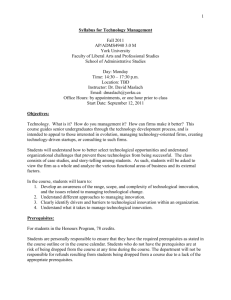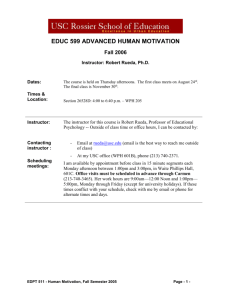Game 600-002 Hudson
advertisement

Computer Game Design Program College of Visual and Performing Arts GAME 600—Research Methodologies Instructor: Seth Hudson Office: AB 2002 Office Hours: W 10:30—12:30 Phone: 993-5734 (for apt.) 3 Credit Hours Lecture: M 4:30-7:10PM Room: Robinson B 210 Fall 2014 shudson3@gmu.edu Prerequisite: Admittance to the MA Game Design Program or permission of instructor Required Texts: Fernandez, Vara, C. (2014). Introduction to Game Analysis. New York: Routledge. Mayra, F. (2008). An Introduction to Game Studies. London: Sage. (eBook available) Newman, J. (2004). Videogames, 2nd. Ed. New York: Routledge Smith, J., Egenfeldt-Nielsen, S., & Tosca, S. (2013). Understanding Video Games : The Essential Introduction. New York: Routledge. (eBook available) ***Other readings available online as ebooks or pdf*** Course Description: This graduate seminar focuses on development of independent research projects in game design, theory, philosophy, criticism and production. Explores principal methods of researching, exploring, and documenting game design and contemporary and historic practice. Along with traditional methods of library research, this course emphasizes new processes of examination and investigation through the use of computer-aided research systems and techniques. Students will research and write a publishable paper following best practices in their chosen field. Assigned readings in the class will be augmented and supported by visual presentations, game play, guest lecturers and field trips. Objectives: To build student awareness about the contemporary research tools and technique available to pursue academic research, as well as about current and historical trends in ‘serious’ and entertainment game theory, philosophy, and criticism. Requirements and Evaluation: At each class meeting, students should be prepared to discuss the assigned readings. Additional out-of-class viewings and game play will be assigned. The assigned readings, visual materials, and games will be either reserved at the Johnson Center Library, or in the Game Program Library. MAJOR PROJECT (40% of Total Grade) At mid-term, each student is required to present a10-page paper (APA, doublespaced), or create a multimedia artifact equal in content that reflects upon, explores, or further examines the theories, issues, and ideas discussed during the first eight weeks of the semester. In preparation for the midterm project, regardless of the medium selected, students are required to provide a 15-minute presentation of their proposed work in the fourth week of the semester. This mid-term presentation will examine the critical, historical, and theoretical issues that the student explored in their mid-term project. In the forth week of the semester, students will prepare the project or paper proposal for approval by the instructor. The proposal must include a draft of your annotated bibliography, citing no fewer than 8 sources. All papers submitted and presented must be in APA format (unless specific submission specifications dictate otherwise) and executed in near-flawless standard written English. By the end of the semester, all students are required to further their research via a 20-page paper addressing the theories, issues and ideas presented in the reading assignments and video screenings from the semester. In the final two classes, students will give a 20-minute presentation and discuss the political, cultural, art historical, and/or theoretical content of their paper. The instructor will provide extensive guidance and advice for each student throughout his or her research and presentation. Students should also find a relevant publication for their paper, preparing submission materials for the actual journal/publication. JOURNAL REFLECTIONS (20%) Students are required to submit a total of FIVE journal entries to the professor. These journal entries should be two pages in length, addressing the specific prompt of the assignment while showing engagement with course texts in addition to personal reflection. LECTURE SESSION (20%) All GAME 600 students will plan and lead a lecture during the semester. Lecture leaders are required to provide an outline of the discussion points, with sample discussion questions, in addition to any standard presentation materials (PDF, video clips, etc.). All materials are due to the instructor no later than 24 hours before the planned session. Lectures will be assessed through instructor and participant feedback. Post lecture, students should schedule a consultation with the instructor. COURSE PARTICIPATION (20%) In-class meetings and online collaboration are a major part of our endeavor. Inclass work will include collaborative, multimedia research projects. Grade % Points A+ 99-100 A 94-98 A90-93 B+ 88-89 B 84-88 B80-83 * Although a B- is a satisfactory grade for a course, students must maintain a 3.00 average in their degree program and present a 3.00 GPA on the courses listed on the graduation application. Recommended Texts: Note: When possible we will utilize ebooks from university libraries. Some other readings may be distributed as PDF files on Bb. Barry, P. (2009). Beginning theory: An introduction to literary and culture theory (2nd ed.). Manchester, UK: Manchester University Press. Beardsley, M. C. (1981). Aesthetics: Problems in the philosophy of criticism. Indianapolis, IN: Harcourt Publishing Company, Inc. Benjamin, W. (2010). ThewWork of art in the age of mechanical reproduction. CreateSpace Independent Publishing Platform (online) Bogost, I. (2008). Unit operations: An approach to videogame criticism. Cambridge, MA: MIT University Press. Cage, J. (1973). Silence: Lectures and writings. Middletown, CT: Wesleyan University Press. Cassell, J. & Jenkins, H. (1998). From barbie to mortal combat: Gender and computer games. Cambridge, MA: MIT Press DeBord, G. (1999). Society of spectacle. New York, NY: Zone Books Harland, R. (2003). New accents: Superstructuralism. New York, NY: Routledge. Hoglund, J. (2008). Electronic empire: Orientalism revisited in the military shooter. Game studies: The international journal of computer game research (8,1). Retrieved from http://gamestudies.org/0801/articles/hoeglund. Kline, S. (2003). Digital play: Interaction of technology, culture, and marketing. Quebec, CA: McGill-Queen’s University Press Lovejoy, M. (1989). Digital currents: Art in the electronic age. New York, NY: UMI Press. Marx, K. (2013). Wage-labour and capital. New York, NY: Hard Press. Nel, P. (2002). The Avant-garde and American postmodernity: Small incisive shocks. Jackson, MS: University of Mississippi Press. Pacey, A. (1983). The Culture of Technology. Cambridge, MA: MIT Press Rand, A. (1986). Capitalism: The unknown ideal. New York, NY: Penguin Publishing. Ruch, A.W. (2012). Grand theft auto IV: Liberty city and modernist literature. Games and Culture, vol. 7, 331-348. Retrieved from http://gac.sagepub.com/content/7/5/331.full.pdf+html Tisdall, C. (1985). Futurism (world art library). New York, NY: Thames & Hudson Walker, J.A. (2001). Art in the age of mass media (3rd ed.). London, UK: Pluto Press











